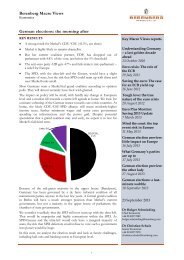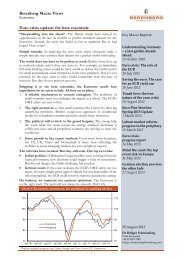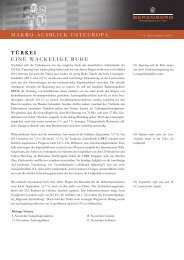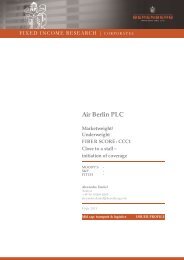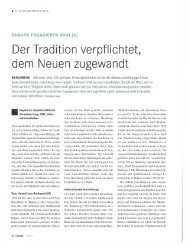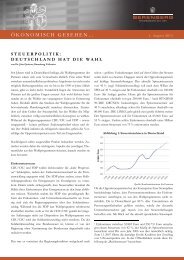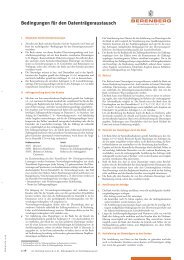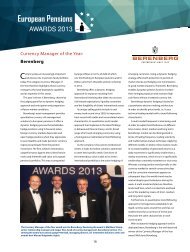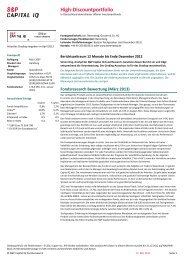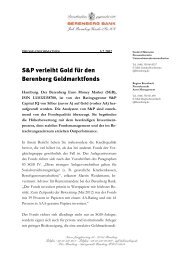Semiconductor Equipment - Berenberg Bank
Semiconductor Equipment - Berenberg Bank
Semiconductor Equipment - Berenberg Bank
Create successful ePaper yourself
Turn your PDF publications into a flip-book with our unique Google optimized e-Paper software.
ASM International NV<br />
Small/Mid-Cap: Technology Hardware<br />
Investment summary<br />
We base our investment thesis on Buy-rated ASMI on the following five points.<br />
1. We expect the ALD market to reach €700m in the next three years:<br />
ASMI generates 60% of its revenue from the ALD market. We expect the<br />
addressable market to expand to €700m (a rise of c20%) in the next three<br />
years, driven by increasing HKMG adoption in foundries and logic. In 2012,<br />
the HKMG process was only adopted by Intel (100% of 22nm capacity),<br />
TSMC (60% of 28nm capacity) and Samsung (100% of 32nm capacity, 0% of<br />
28nm capacity). We expect TSMC, Samsung and other tier two foundries<br />
(such as Globalfoundries and UMC) to increase their HKMG-based capacity<br />
significantly in the next two years because HKMG is essential for building<br />
20nm/below chips. We do not expect ASMI to lose market share: it has<br />
accumulated a comprehensive IP portfolio on ALD technology. TEL, the only<br />
other main player in this market, currently licenses ASMI’s IP to make ALD<br />
tools.<br />
2. Market expansion driven by new epitaxy tools: ASMI’s previous epitaxy<br />
tool (17% of revenue) only addressed the power devices and analog markets;<br />
however, in 2012, it released a new epitaxy tool model (Intrepid XP) that<br />
targeted the logic market. We expect the epitaxy market to expand to €500m<br />
in the next three years from €423m today (a rise of c9% per year). Given<br />
ASMI’s strong relationship with Intel and Intel’s dual-sourcing policy, we<br />
believe that ASMI could gain orders from Intel and serve as its secondary<br />
supplier, after AMAT. We believe its market share may, therefore, expand<br />
from the current 10% level to 11% in 2015.<br />
3. ASMI’s front-end business worth more than $800m today: AMAT and<br />
Francisco Partners offered to acquire ASMI’s front-end business for $800m in<br />
2008. The price looked expensive due to a private equity buyout valuation<br />
premium before the financial crisis. We believe the front-end business is worth<br />
more than $800m today (worth $949m as per our valuation) because it is in a<br />
better position than it was in 2008. This is because: 1) ASMI’s market share in<br />
the ALD market has risen by 6% since 2008 to 44% in 2012; 2) 3D NAND<br />
will boost PE CVD (14% of revenue) in 2014/15, an opportunity that did not<br />
exist in 2008; and 3) ASMI could gain epitaxy orders with its newly launched<br />
tool and increase its exposure to strong logic capex.<br />
4. Further ASMP share disposal is a catalyst given investor frustration:<br />
ASMI’s share price is affected by its holding in ASMP, a non-strategic asset.<br />
We think that management has aligned its interest with shareholders (as<br />
demonstrated by the founder’s comments at the 2012 AGM). ASMI has<br />
already sold down a 12% tranche, and we expect it to sell further tranches<br />
following the September lock-up expiry. The market has been disappointed<br />
that the full stake was not disposed of. Our view is that a structured selling of<br />
the holding is the optimal approach as a better value can be realised.<br />
5. SOTP – 65% of ASMI’s share value comes from ASMP: In our SOTP,<br />
65% of ASMI’s share value comes from its 40% holding in ASMP, which we<br />
value based on ASMP’s share price after applying a 5% holding discount. We<br />
value ASMI’s front-end business at €10/share by applying 14x P/E on 2014<br />
EPS of €0.81.<br />
54


